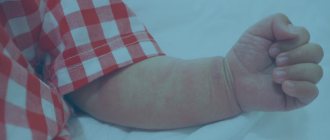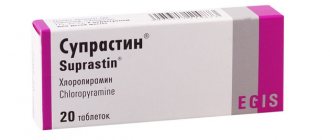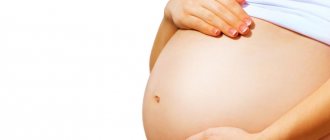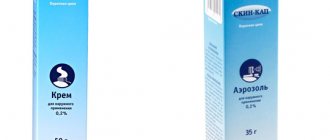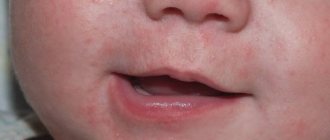Atopic dermatitis51
This is a multifactorial chronic inflammatory skin disease, which is characterized by itching, relapses, age-related features of the location and morphology of the affected areas. In the pathogenesis of the disease, a special place is occupied by hereditary determination, due to which the following occurs:
- the skin barrier is broken;
- immune system defects occur;
- hypersensitivity to allergens appears;
- pathogenic microflora develops;
- the functioning of the autonomic nervous system is disrupted, resulting in an increase in the synthesis of inflammatory mediators.
Acne on a child's body associated with the manifestation of atopic dermatitis occurs in 20% of children.
In different age periods, the manifestations of atopic dermatitis differ:
- Infant. It appears in the first 3 months of a baby’s life. The clinical picture is dominated by erythematous spots, vesicles, papules located on the forehead, cheeks, and scalp. There is severe itching, weeping, and swelling. The location of the disease is the extensor and flexion surfaces of the limbs.
- Children's. This period is characterized by a rash represented by papules, papulovesicles, erythematous-squamous formations located on the arms (elbows, wrists, forearms), legs (feet, knees, ankles).
- Teenage and adult. Rashes on the child’s body are concentrated on the flexor surfaces of the arms and legs, on the back of the neck, and in the behind-the-ear areas. The disease is characterized by the appearance of erythema, peeling, papules, cracks, and infiltration.
What causes acne and what causes it
While stress may not cause acne, it can make existing acne worse. Research shows that when stress increases, the severity of acne increases. Acne may get worse if teens:
- sleep too little;
- eat certain foods traditional to the Western diet;
- use oily cosmetics and skin care products.
Almost everyone experiences at least a few breakouts during their teenage years. It is impossible to predict who will develop more severe acne, but there is an increased risk if one or both parents (or other close blood relatives) have had severe acne that results in scarring.
Acne18
Acne is also a chronic inflammatory disease that is prone to recurrence. As with atopic dermatitis, there is a genetic predisposition to acne. But acne is a disease of the pilosebaceous follicles.
Childhood acne has its own characteristics depending on age:
- Infant. They are represented by closed comedones, localized on the chin, forehead, and cheeks. Papules and pustules are much less common.
- Acne in early childhood. Rash in the form of comedones, papules, pustules, nodes rarely appear. The location is mainly on the face.
- Middle aged acne. Mostly comedones and inflammatory elements appear on the face.
- Preteen. At 7-12 years old, acne on the face may indicate early puberty. The first to appear during this period are, as a rule, black dots in various areas.
Acne classification
Dermatologists distinguish the following 3 degrees of acne severity:
- Easy. When there are less than 20 pores (comedones) clogged with subcutaneous fat.
- Average. The number of comedones can reach up to 100.
- Severe disease with more than 100 comedones.
Regardless of the severity of the pathology, after 20 years the disease, as a rule, fades away or disappears completely; in exceptional cases, cases of acne may occur in some women up to 40 years of age.
Treatment of pimples on a child’s body
If a child has pimples on his body, he should consult a dermatologist. Only a doctor can accurately determine their cause and prescribe the correct treatment. One of the groups of drugs that can be prescribed by a dermatologist for acne are topical antibiotics18. Please note that they have age restrictions. For example, Clindovit® gel is not recommended for use under 12 years of age6.
Clindovit® is a gel that helps fight acne. The main active ingredient in its composition is the antibiotic lincosamide clindamycin6. The drug exhibits antibacterial activity against a large number of strains of propionibacteria6. Clindovit® helps reduce the level of free fatty acids on the skin6. To reduce the risk of antibiotic resistance, it is recommended to combine the use of the drug with the use of azelaic acid (for example, Azelik® gel) or benzoyl peroxide28.
Acne in children and adults
Good afternoon. My name is Ermakova Tatyana Gennadievna. I am a dermatologist at the Scandinavia Clinic. Today I want to talk about such a topical topic for every person as acne in children and adults. Almost every person in adolescence faces this problem to a greater or lesser extent. This applies to adults too. Typically, acne begins around age 10. Its peak is observed at 15-16 years of age. Then, if this is a normal situation, then the process gradually subsides, but in some people acne persists until the age of 35-40.
I would like to dwell on the concept of seborrhea, which underlies the disease of acne. Seborrhea is a skin disease that is associated with increased production of sebum by the sebaceous glands. This is a genetically determined disease, it is hereditary and is characterized by an associated inflammatory reaction from the sebaceous glands. There is such a thing: seborrheic zones. These are the areas of the skin in which the largest accumulation of sebaceous glands is present, up to 1000 per 1 cm2 of skin. This is the face, upper torso, chest, back. Acne manifestations are most often observed in these places. Why does this occur in teenagers? Because under the influence of sex hormones, in particular testosterone and progesterone, stimulation of the sebaceous glands occurs, which leads to excess production of sebum. At the same time, the exfoliation of horn cells in the mouths of the sebaceous glands is disrupted, and they form a horn plug, which is known as a comedon or blackhead. That is, a situation occurs that, on the one hand, the sebaceous gland works in excess mode and produces a large amount of sebum, and on the other hand, the horny plug prevents it from leaking onto the surface of the skin, and the sebaceous gland continues to work actively, it increases in size , swelling forms, then aseptic inflammation. Subsequently, with the participation of all the microbes that are found on the skin of any person - this is staphylococcus, propionibacterium acnes, septic inflammation occurs, or the appearance of an abscess, which most worries our patients.
A similar mechanism for the formation of acne is observed in adult women who have hormonal disorders, in particular polycystic ovary syndrome, which also leads to excess production of progesterone, testosterone and, conversely, a decrease in estrogen. There, too, the same mechanisms underlie the formation of acne. Therefore, we treat adult women for acne together with gynecologists-endocrinologists, who are specifically involved in the correction of hormonal disorders.
I'll tell you more about teenagers. Often at the age of 10, the formation of comedones, blackheads in the middle part of the face is observed, this is the forehead, chin and nose. This is a mild degree of severity of the process and often nothing is done about it, and they do not go to the doctor. In principle, there are now methods that can influence this process and suppress it at this initial stage in order to prevent more serious manifestations of acne from developing in the future. In general, in general, I want to say that adult women with acne, of course, go to the doctor, because it affects their appearance. Naturally, any person who has manifestations on the face will, of course, turn to a dermatologist. This is not always the case for teenagers and their parents. Many people believe that acne is a disease that happens to everyone, which is typical for adolescence. This is not even a disease, nothing needs to be done about it, it will go away on its own. Many apply when it has already become a severe form, when there are already deep elements that, after they pass, leave scars, and then the person lives with these scars all his life.
Separately, I would like to dwell on the systemic use of vitamin A derivatives; this is a whole line of drugs that appeared on the market about 20 years ago. As a practicing dermatologist, I can say that this has made a very big difference in the treatment of patients, especially with severe and moderate forms of acne. Previously, such patients spent years going from dermatologist to cosmetologist, undergoing many often very painful procedures, which, unfortunately, had a temporary effect and the disease ended when each sebaceous gland turned into a scar. Now such patients have the opportunity, after taking the drug orally for 6-8 months, to get rid of this problem by 95%. As a doctor, I can say that it gives me the greatest moral satisfaction in my work when a teenager with long bangs comes to me, who is afraid to look up at me, and when, after 2 months of treatment, he opens the door, smiles and says: “Hello , Doctor,” then this, of course, is very pleasant.
Right away, I want to warn patients who may decide to self-treat with such drugs not to do so. Treatment is a fairly serious step; there are a number of side effects that depend on the dose of the drug. If you do not follow all the details of treatment, it can negate all the efforts and resources spent. Once again, I want to emphasize that currently there are methods of influencing all forms of acne, from mild to severe, there is no need to delay consulting a doctor, especially if you see that scars are forming. Because the longer we wait, the more scars a person will develop on his face, and he will live with them for the rest of his life. Once again, I want to emphasize that acne is not only a cosmetic problem, it is a serious skin disease that can currently be treated. In addition to modern external therapy, we can also use systemic drugs, and in any case, I recommend that patients seek help from a dermatologist.
Date of publication: 05/05/16
Types of acne, formation mechanism and what they look like
Teenage acne on the face of adolescents can be of several types (or a combination of them). Source: Pathogenetic rationale for local acne therapy in adolescence. Mazitova L.P., Aslamazyan L.K., Kvachakhiya L.L., Namazova L.S. Pediatric pharmacology, 2008. pp. 94-97):
- whiteheads;
- black dots;
- acne;
- nodules, cysts, or both (deep and painful).
- Whiteheads . Removing whiteheads can lead to more whiteheads and acne scars, which is why dermatologists recommend treating whiteheads with an acne treatment rather than picking at them. Whiteheads form when excess oil and dead skin cells clog the pores. This causes white or flesh-colored pimples to appear. Medical name: closed comedon, which means “closed pore.”
- Black dots . Dermatologists recommend treating this type of acne with a retinoid, since squeezing the blackheads can cause infection or permanent scarring. This type of acne also develops when excess sebum and dead skin cells accumulate inside the pore. As the secretion accumulates, it expands the pores and you see blackheads. Many people mistakenly believe that a black spot is dirt. What you are actually seeing is a chemical reaction. When deposits inside the pore react with oxygen in the air, a black color appears. Medical name: open comedo, which means “open pore.”
- Sometimes excess oil, dead skin cells and bacteria get trapped in the pores. Bacteria, which are usually found on our skin, can multiply quickly in excess oil. As the pores become filled with bacteria, inflammation (swelling) develops and a pimple appears. Medical name: If a pimple contains pus, it is called a pustule . A pimple without pus is called a papule .
- Nodule or cyst . When the pores become filled with excess oil, dead skin cells and bacteria, causing inflammation (swelling) that penetrates deep into the skin, a lump or cyst forms. Because these rashes penetrate deep into the skin, they can be painful. The main difference between a nodule and a cyst is that the cyst contains pus. Because nodules do not contain pus, they feel firmer to the touch than cysts.

